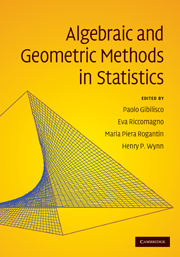Book contents
- Frontmatter
- Contents
- List of contributors
- Preface
- Frequently used notations and symbols
- 1 Algebraic and geometric methods in statistics
- Part I Contingency tables
- Part II Designed experiments
- 9 Generalised design: interpolation and statistical modelling over varieties
- 10 Design of experiments and biochemical network inference
- 11 Replicated measurements and algebraic statistics
- 12 Indicator function and sudoku designs
- 13 Markov basis for design of experiments with three-level factors
- Part III Information geometry
- Part IV Information geometry and algebraic statistics
- Part V On-line supplements
9 - Generalised design: interpolation and statistical modelling over varieties
from Part II - Designed experiments
Published online by Cambridge University Press: 27 May 2010
- Frontmatter
- Contents
- List of contributors
- Preface
- Frequently used notations and symbols
- 1 Algebraic and geometric methods in statistics
- Part I Contingency tables
- Part II Designed experiments
- 9 Generalised design: interpolation and statistical modelling over varieties
- 10 Design of experiments and biochemical network inference
- 11 Replicated measurements and algebraic statistics
- 12 Indicator function and sudoku designs
- 13 Markov basis for design of experiments with three-level factors
- Part III Information geometry
- Part IV Information geometry and algebraic statistics
- Part V On-line supplements
Summary
Abstract
In the classical formulation an experimental design is a set of sites at each of which an observation is taken on a response Y. The algebraic method treats the design as giving an ‘ideal of points’ from which potential monomial bases for a polynomial regression can be derived. If the Gröbner basis method is used then the monomial basis depends on the monomial term ordering. The full basis has the same number of terms as the number of design points and gives an exact interpolator for the Y -values over the design points. Here, the notation of design point is generalised to a variety. Observation means, in theory, that one observes the value of the response on the variety. A design is a union of varieties and the assumption is, then, that on each variety we observe the response. The task is to construct an interpolator for the function between the varieties. Motivation is provided by transect sampling in a number of fields. Much of the algebraic theory extends to the general case, but special issues arise including the consistency of interpolation at the intersection of the varieties and the consequences of taking a design of points restricted to the varieties.
Introduction
Experimental design is defined simply as the choice of sites, or observation points, at which to observe a response, or output. A set of such points is the experimental design. Terminology varies according to the field. Thus, sites may be called ‘treatment combinations’, ‘input configurations’, ‘runs’, ‘data points’ and so on. For example in interpolation theory ‘observation point’ is common.
- Type
- Chapter
- Information
- Algebraic and Geometric Methods in Statistics , pp. 159 - 174Publisher: Cambridge University PressPrint publication year: 2009
- 1
- Cited by



